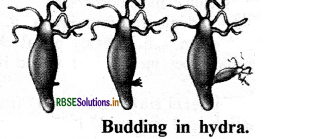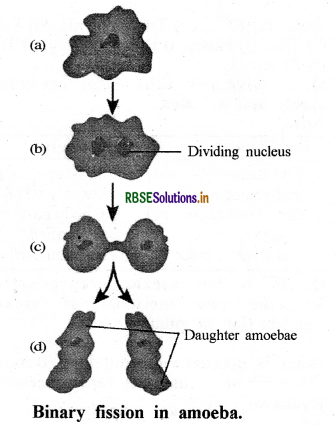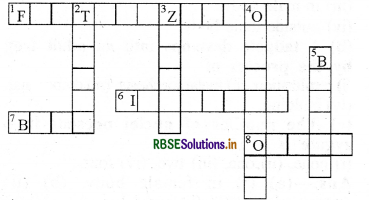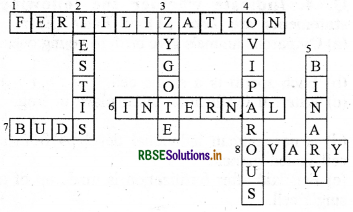RBSE Solutions for Class 8 Science Chapter 9 Reproduction in Animals
Rajasthan Board RBSE Solutions for Class 8 Science Chapter 9 Reproduction in Animals Textbook Exercise Questions and Answers.
Rajasthan Board RBSE Solutions for Class 8 Science in Hindi Medium & English Medium are part of RBSE Solutions for Class 8. Students can also read RBSE Class 8 Science Important Questions for exam preparation. Students can also go through RBSE Class 8 Science Notes to understand and remember the concepts easily. Browsing through class 8 science chapter 14 extra questions that includes all questions presented in the textbook.
RBSE Class 8 Science Solutions Chapter 9 Reproduction in Animals
RBSE Class 8 Science Reproduction in Animals InText Questions and Answers
Page 101
Question 1.
What purpose does the tail in a sperm serve?
Answer:
In sperm tail helps in motion. By the help of it sperm swims and reaches to ovum.

Page 103
Question 2.
Why do fish and frogs lay eggs in hundreds whereas a hen lays only one egg at a time?
Answer:
Though fish and frogs lay hundreds of eggs and release millions of sperms but all the eggs do not get fertilized. This is because the eggs and sperms get exposed to water movement, wind and rainfall. Also, there are other animals in the pond which may feed on eggs.
Thus production of large number of eggs and sperms is necessary to ensure fertilization of at least a few of them. In hen internal fertilization takes place and egg remains protected. After fertilization the egg comes out from female body and develops a new being.
Page 104
Question 3.
How could a single cell become such a big individual?
Answer:
Fertilized egg is a single cell. Fertilization results in the formation of zygote which develops in different steps to form a big individual.
RBSE Class 8 Science Reproduction in Animals Textbook Questions and Answers
Question 1.
Explain the importance of reproduction in organisms.
Answer:
Due to following reasons reproduction is important for living organisms:
- It ensures the continuation of life on earth.
- More individuals develop having the basic characters like parents.
- Transfer of useful variations from one generation to other generation.
Question 2.
Describe the process of fertilization in human beings.
Answer:
The testes produce the male gametes called sperms. Millions of sperms are produced by the testes. Ovary produces female gametes called ova (eggs). When sperms come in contact with an egg, one of the sperms may fuse with the egg. Such fusion of the egg and the sperm is called fertilization. During fertilization, the nuclei of the sperm and the egg fuse to form a single nucleus. This results in the formation of a zygote.

Question 3.
Choose the most appropriate answer:
(a) Internal fertilization occurs
(i) in female body.
(ii) outside female body.
(iii) in male body.
(iv) outside male body.
(b) A tadpole develops into an adult frog by the process of
(i) fertilization
(ii) metamorphosis
(iii) embedding
(iv) budding.
(c) The number of nuclei present in a zygote is
(i) none
(ii) one
(iii) two
(iv) four.
Answer:
(a) (i) in female body
(b) (ii) metamorphosis
(c) (ii) one.
Question 4.
Indicate whether the following statements are True (T) or False (F):
(a) Oviparous animals give birth to young ones. ( )
(b) Each sperm is a single cell. ( )
(c) External fertilization takes place in frog. ( )
(d) A new human individual develops from a cell called gamete. ( )
(e) Egg laid after fertilization is made up of a single cell. ( )
(f) Amoeba reproduces by budding. ( )
(g) Fertilization is necessary even in asexual reproduction. ( )
(h) Binary fission is a method of asexual reproduction. ( )
(i) A zygote is formed as a result of fertilization. ( )
(j) An embryo is made up of a single cell. ( )
Answer:
(a) False
(b) True
(c) True
(d) False
(e) True
(f) False
(g) False
(h) True
(i) True
(j) False.

Question 5.
Give two differences between a zygote and a foetus.
Answer:
|
Zygote |
Foetus |
|
1. The fusion of ovum and sperm results in the formation of |
1. The stage of the embryo in which all the body parts can be identified. |
|
2. It is a single cell. |
2. This is multicellular. |
Question 6.
Define asexual reproduction. Describe two methods of asexual reproduction in animals.
Or
What is asexual reproduction? Describe the method of asexual reproduction in Hydra with diagram.
Answer:
Asexual reproduction: Reproduction in which only a single parent is involved is called asexual repeoduction.
Two methods of asexual reproduction are as follows:
1. Budding:
In hydra and yeast asexual reproduction is a usual process. In this process a bulb like structure develop on the body, called bud. The nucleus of the body is divided into two parts and from this one nucleus comes in the bud. Bud is separated from parent individual and grows and folly develops to form a new individual.

2. Binary fission:
In this process parent individual divides to form two new individuals. Reproduction in amoeba takes place by binary fission. When the amoeba cell reaches the maximum size of its growth, then firstly the nucleus of amoeba gets elongated and divides into two parts.

This is followed by division of its body into two, each part receiving a nucleus. Finally, two amoebae are produced from one parent amoeba.

Question 7.
In which female reproductive organ does the embryo get embedded?
Answer:
The embryo gets embedded in the wall of the uterus for further development.
Question 8.
What is metamorphosis? Give examples.
Answer:
Metamorphosis:
The transformation of the larva into an adult through drastic changes is called metamorphosis.
Example: Tadpole transform into adult, it can jump and swim. After some special changes tadpole undergoes metamorphosis and become adult.
Question 9.
Differentiate between internal fertilization and external fertilization.
Answer:
|
Internal Fertilization |
External fertilization |
|
1. Male and female gamete fuse inside the female body. |
1. Male and female gamete fuse outside the body of female. |
|
2. Male puts the sperms in the body of the female. |
2. Both population liberate the gametes outside. |
|
3. Development takes place inside the body. Example : Humans, animals, shark, birds |
3. Development takes place outside the body. Example: Frog. |

Question 10.
Complete the cross - word puzzle using the hints given below:
Across
1. The process of the fusion of the gametes.
6. The type of fertilization in hen.
7. The term used for bulges observed on the sides of the body of Hydra.
8. Eggs are produced here.
Down
2. Sperms are produced in these male reproductive organs.
3. Another term for in vitro fertilized egg.
4. These animals lay eggs.
5. A type of fission in amoeba.

Answer:


- RBSE Class 8 Science Notes in Hindi & English Medium Pdf Download
- RBSE Class 8 Science Important Questions in Hindi Medium & English Medium
- RBSE Solutions for Class 8 Science in Hindi Medium & English Medium
- RBSE Class 8 Science Important Questions Chapter 14 Chemical Effects of Electric Current
- RBSE Class 8 Science Notes Chapter 16 Light
- RBSE Class 8 Science Notes Chapter 1 Crop Production and Management
- RBSE Class 8 Science Notes Chapter 2 Microorganisms: Friend and Foe
- RBSE Class 8 Science Notes Chapter 3 Synthetic Fibres and Plastics
- RBSE Class 8 Science Notes Chapter 4 Materials: Metals and Non-Metals
- RBSE Class 8 Science Notes Chapter 5 Coal and Petroleum
- RBSE Class 8 Science Notes Chapter 6 Combustion and Flame